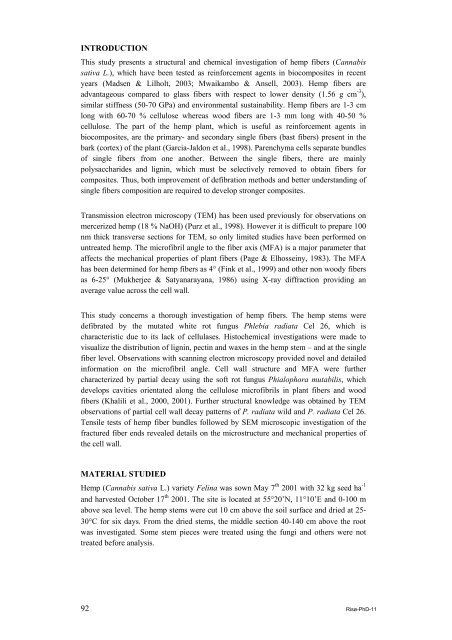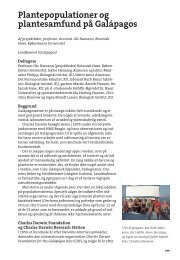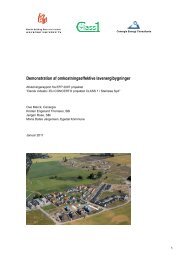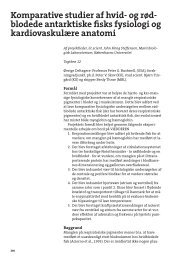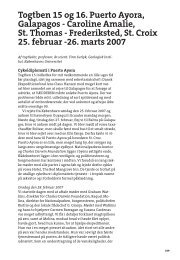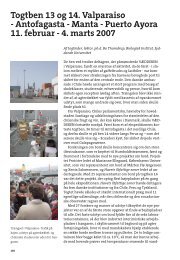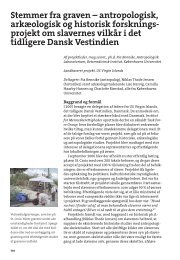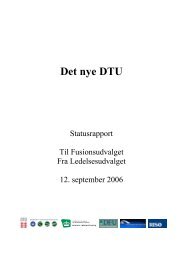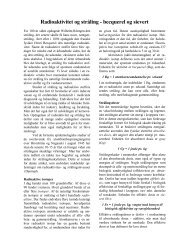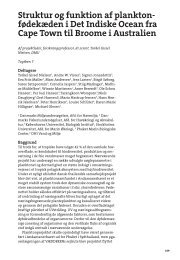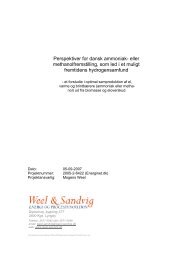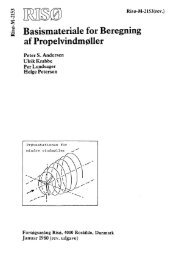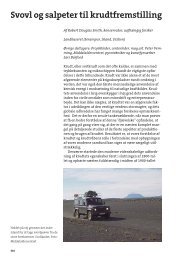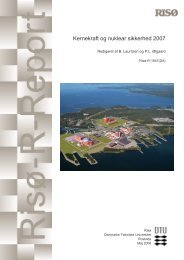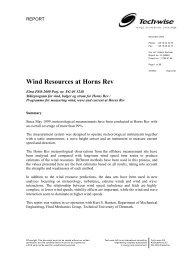Properties of hemp fibre polymer composites -An optimisation of ...
Properties of hemp fibre polymer composites -An optimisation of ...
Properties of hemp fibre polymer composites -An optimisation of ...
Create successful ePaper yourself
Turn your PDF publications into a flip-book with our unique Google optimized e-Paper software.
INTRODUCTION<br />
This study presents a structural and chemical investigation <strong>of</strong> <strong>hemp</strong> fibers (Cannabis<br />
sativa L.), which have been tested as reinforcement agents in bio<strong>composites</strong> in recent<br />
years (Madsen & Lilholt, 2003; Mwaikambo & <strong>An</strong>sell, 2003). Hemp fibers are<br />
advantageous compared to glass fibers with respect to lower density (1.56 g cm -3 ),<br />
similar stiffness (50-70 GPa) and environmental sustainability. Hemp fibers are 1-3 cm<br />
long with 60-70 % cellulose whereas wood fibers are 1-3 mm long with 40-50 %<br />
cellulose. The part <strong>of</strong> the <strong>hemp</strong> plant, which is useful as reinforcement agents in<br />
bio<strong>composites</strong>, are the primary- and secondary single fibers (bast fibers) present in the<br />
bark (cortex) <strong>of</strong> the plant (Garcia-Jaldon et al., 1998). Parenchyma cells separate bundles<br />
<strong>of</strong> single fibers from one another. Between the single fibers, there are mainly<br />
polysaccharides and lignin, which must be selectively removed to obtain fibers for<br />
<strong>composites</strong>. Thus, both improvement <strong>of</strong> defibration methods and better understanding <strong>of</strong><br />
single fibers composition are required to develop stronger <strong>composites</strong>.<br />
Transmission electron microscopy (TEM) has been used previously for observations on<br />
mercerized <strong>hemp</strong> (18 % NaOH) (Purz et al., 1998). However it is difficult to prepare 100<br />
nm thick transverse sections for TEM, so only limited studies have been performed on<br />
untreated <strong>hemp</strong>. The micr<strong>of</strong>ibril angle to the fiber axis (MFA) is a major parameter that<br />
affects the mechanical properties <strong>of</strong> plant fibers (Page & Elhosseiny, 1983). The MFA<br />
has been determined for <strong>hemp</strong> fibers as 4° (Fink et al., 1999) and other non woody fibers<br />
as 6-25° (Mukherjee & Satyanarayana, 1986) using X-ray diffraction providing an<br />
average value across the cell wall.<br />
This study concerns a thorough investigation <strong>of</strong> <strong>hemp</strong> fibers. The <strong>hemp</strong> stems were<br />
defibrated by the mutated white rot fungus Phlebia radiata Cel 26, which is<br />
characteristic due to its lack <strong>of</strong> cellulases. Histochemical investigations were made to<br />
visualize the distribution <strong>of</strong> lignin, pectin and waxes in the <strong>hemp</strong> stem – and at the single<br />
fiber level. Observations with scanning electron microscopy provided novel and detailed<br />
information on the micr<strong>of</strong>ibril angle. Cell wall structure and MFA were further<br />
characterized by partial decay using the s<strong>of</strong>t rot fungus Phialophora mutabilis, which<br />
develops cavities orientated along the cellulose micr<strong>of</strong>ibrils in plant fibers and wood<br />
fibers (Khalili et al., 2000, 2001). Further structural knowledge was obtained by TEM<br />
observations <strong>of</strong> partial cell wall decay patterns <strong>of</strong> P. radiata wild and P. radiata Cel 26.<br />
Tensile tests <strong>of</strong> <strong>hemp</strong> fiber bundles followed by SEM microscopic investigation <strong>of</strong> the<br />
fractured fiber ends revealed details on the microstructure and mechanical properties <strong>of</strong><br />
the cell wall.<br />
MATERIAL STUDIED<br />
Hemp (Cannabis sativa L.) variety Felina was sown May 7 th 2001 with 32 kg seed ha -1<br />
and harvested October 17 th 2001. The site is located at 55°20’N, 11°10’E and 0-100 m<br />
above sea level. The <strong>hemp</strong> stems were cut 10 cm above the soil surface and dried at 25-<br />
30°C for six days. From the dried stems, the middle section 40-140 cm above the root<br />
was investigated. Some stem pieces were treated using the fungi and others were not<br />
treated before analysis.<br />
92 Risø-PhD-11


